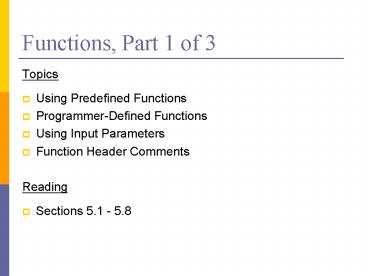Functions, Part 1 of 3 - PowerPoint PPT Presentation
1 / 16
Title:
Functions, Part 1 of 3
Description:
Function Header Comments ... and repetition control structures. ... function call this is a string we are passing as an argument ... – PowerPoint PPT presentation
Number of Views:51
Avg rating:3.0/5.0
Title: Functions, Part 1 of 3
1
Functions, Part 1 of 3
- Topics
- Using Predefined Functions
- Programmer-Defined Functions
- Using Input Parameters
- Function Header Comments
- Reading
- Sections 5.1 - 5.8
2
Review of Structured Programming
- Structured programming is a problem solving
strategy and a programming methodology that
includes the following guidelines - The program uses only the sequence, selection,
and repetition control structures. - The flow of control in the program should be as
simple as possible. - The construction of a program embodies top-down
design.
3
Review of Top-Down Design
- Involves repeatedly decomposing a problem into
smaller problems - Eventually leads to a collection of small
problems or tasks each of which can be easily
coded - The function construct in C is used to write code
for these small, simple problems.
4
Functions
- A C program is made up of one or more functions,
one of which is main( ). - Execution always begins with main( ), no matter
where it is placed in the program. By
convention, main( ) is located before all other
functions. - When program control encounters a function name,
the function is called (invoked). - Program control passes to the function.
- The function is executed.
- Control is passed back to the calling function.
5
Sample Function Call
- include ltstdio.hgt
- int main ( ) printf is the name of a predefined
- function in the stdio library
- printf (Hello World!\n)
this statement is - return 0
is known as a -
function call - this is a string we are passing
- as an argument (parameter) to
- the printf function
6
Functions (cont.)
- We have used three predefined functions so far
- printf
- scanf
- getchar
- Programmers can write their own functions.
- Typically, each module in a programs design
hierarchy chart is implemented as a function. - C function names follow the same naming rules as
C variables.
7
Sample Programmer-Defined Function
- include ltstdio.hgt
- void printMessage ( void )
- int main ( )
- printMessage ( )
- return 0
- void printMessage ( void )
- printf (A message for you\n\n)
- printf (Have a nice day!\n)
8
Examining printMessage
include ltstdio.hgt void printMessage ( void )
function prototype int main (
) printMessage ( ) function
call return 0 void printMessage (
void ) function header printf (A message
for you\n\n) function printf
(Have a nice day!\n)
body
function definition
9
The Function Prototype
- Informs the compiler that there will be a
function defined later that - returns this type
- has this name
- takes these arguments
- void printMessage (void)
- Needed because the function call is made before
the definition -- the compiler uses it to see if
the call is made properly
10
The Function Call
- Passes program control to the function
- Must match the prototype in name, number of
arguments, and types of arguments - void printMessage (void)
- int main ( ) same name no arguments
- printMessage ( )
- return 0
11
The Function Definition
- Control is passed to the function by the function
call. The statements within the function body
will then be executed. - void printMessage ( void )
- printf (A message for you\n\n)
- printf (Have a nice day!\n)
- After the statements in the function have
completed, control is passed back to the calling
function, in this case main( ) . Note that the
calling function does not have to be main( ) .
12
General Function Definition Syntax
- type functionName ( parameter1, . . . ,
parametern ) - variable declaration(s)
- statement(s)
- If there are no parameters, either
- functionName( ) OR functionName(void)
- is acceptable.
- There may be no variable declarations.
- If the function type (return type) is void, a
return statement is not required, but the
following are permitted - return OR return( )
13
Using Input Parameters
- void printMessage (int counter)
- int main ( )
- int num
- printf (Enter an integer )
- scanf (d, num)
- printMessage (num) one argument
matches the one formal parameter - return 0 of type int
of type int - void printMessage (int counter)
- int i
- for ( i 0 i lt counter i )
- printf (Have a nice day!\n)
14
Final Clean C Code
- include ltstdio.hgt
- void printMessage (int counter)
- int main ( )
- int num / number of times to print
message / - printf (Enter an integer )
- scanf (d, num)
- printMessage (num)
- return 0
15
Final Clean C Code (cont).
/
printMessage - prints
a message a specified number of times Inputs
counter - the number of times the message will
be printed
Outputs None /
/ void
printMessage ( int counter ) int i /
loop counter / for ( i 0 i lt counter
i ) printf (Have a nice
day!\n)
16
Good Programming Practice
- Notice the function header comment before the
definition of function printMessage. - This is a good practice and is required by the
104 C Coding Standards. - Your header comments should be neatly formatted
and contain the following information - function name
- function description (what it does)
- a list of any input parameters and their meanings
- a list of any output parameters and their
meanings - a description of any special conditions

